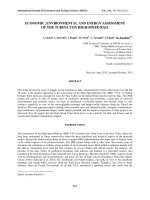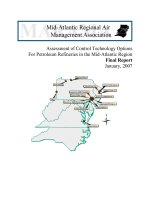Reliability assessment and energy storage solution for renewable energy integration
Bạn đang xem bản rút gọn của tài liệu. Xem và tải ngay bản đầy đủ của tài liệu tại đây (2.62 MB, 225 trang )
RELIABILITY ASSESSMENT AND ENERGY STORAGE
SOLUTION FOR RENEWABLE ENERGY
INTEGRATION
SHU ZHEN
A THESIS SUBMITTED
FOR THE DEGREE OF DOCTOR OF
PHILOSOPHY
DEPARTMENT OF ELECTRICAL AND
COMPUTER ENGINEERING
NATIONAL UNIVERSITY OF SINGAPORE
2014
DECLARATION
I hereby declare that this thesis is my original
work and it has been written by me in its entirety.
I have duly acknowledged all the sources of
information which have been used in the thesis.
This thesis has also not been submitted for any
degree in any university previously.
Shu Zhen
April 2014
i
Acknowledgements
First and foremost, I would like to express my deep gratitude to my supervisor
Dr. Panida Jitutitijaroen. She introduced me into this research community and
provided valuable opportunities for me to develop professional skills. Her insightful
guidance and advice have helped me successfully accomplish each milestone
throughout the entire process from starting Ph.D. topic to finishing this thesis. Her
constant encouragement, patience and support have made my Ph.D. experience
productive and stimulating. Her enthusiasm and positive attitude have benefited me a
lot in both academic record and personal life. I would like to give my best wishes to
Dr. Panida Jirutitijaroen and her family.
I am sincerely thankful to my thesis committee members for their time and
constructive comments. I am also thankful to Dr. Chanan Singh and Dr. Armando
Martins Leite da Silva for enlightening discussions and suggestions on my work.
I gratefully acknowledge the financial support from National Research
Foundation Clean Energy Program as well as academic assistance from Department
of Electrical and Computer Engineering and National University of Singapore.
I am grateful to my qualifying examiners Dr. Akshay Kumar Rathore and Dr.
Chang Che Sau for their time and support in my work. I thank Mr. Seow Hung Cheng,
Xiong Peng, Saranga, Bordin and all the other colleagues in the power systems
laboratory; I also want to thank my friends Long Jian, Gu Qingyang, Gu Yisha and
Cao Guopeng. I greatly cherish our friendships that have made my Ph.D. life much
more enjoyable.
ii
Most of all, I would like to thank my parents, Shu Jianrong and Wang Xuejin, as
well as my grandparents. Without their unconditional love and care, I could not have
made my journey this far. I also want to thank my best friend and husband, Tang
Xinyi, who is always staying with me as a faithful supporter in good and bad times.
iii
TABLE OF CONTENTS
ABSTRACT vii
LIST OF TABLES viii
LIST OF FIGURES x
LIST OF SYMBOLS xii
LIST OF ABBREVIATIONS xviii
CHAPTER I: INTRODUCTION 1
1.1 Background and Motivation 1
1.2 Objectives and Contributions 5
1.3 Thesis Outline 7
CHAPTER II: NON-SEQUENTIAL SIMULATION METHODS FOR RELIABILITY
ANALYSIS OF POWER SYSTEMS WITH RENEWABLE ENERGY SOURCES 9
2.1 Introduction 9
2.2 Incorporating Correlations among Load and Renewable Generations 12
2.3 Monte Carlo Random Sampling Methods 13
2.3.1 Load Duration Method 13
2.3.2 Linear Regression Method 14
2.3.3 Joint Probability Method 16
2.4 Proposed Latin Hypercube Sampling Methods 16
2.4.1 Latin Hypercube Sampling with Load Duration 20
2.4.2 Latin Hypercube Sampling with Linear Regression 20
2.4.3 Latin Hypercube Sampling with Joint Probability 20
2.4.4 Latin Hypercube Sampling with Rank Correlation 21
2.5 Case Studies 23
2.5.1 ERCOT System 24
2.5.2 IEEE RTS 29
2.6 Summary 33
CHAPTER III: SEQUENTIAL SIMULATION METHODS FOR RELIABILITY ANALYSIS
OF COMPOSITE POWER SYSTEMS 36
3.1 Introduction 36
3.2 Classification of Sequential Simulation 40
3.2.1 Fixed Time Interval Method 41
3.2.2 Next Event Method 42
iv
3.3 Accelerated State Evaluation Approach 43
3.3.1 Algorithm 45
3.3.1.1 Calculation for Threshold Load Level 45
3.3.1.2 Calculation for States of Loss of Load 46
3.3.2 Extension to Systems with Arbitrary Load Correlations 48
3.4 Latin Hypercube Sampling Method for Sequential Simulation 49
3.5 Case Studies 51
3.5.1 Systems with Correlated Loads 53
3.5.1.1 Case 1 – IEEE RTS 53
3.5.1.2 Case 2 – IEEE RTS with Stressed Transmission Network 56
3.5.1.3 Case 3 – IEEE RTS with Single Generating Unit per Bus 59
3.5.2 Systems without Fully Correlated Loads 62
3.5.2.1 IEEE RTS with Modified Bus Loads 62
3.5.2.2 An Extreme Case 65
3.6 Summary 67
CHAPTER IV: OPTIMAL SIZING OF ENERGY STORAGE SYSTEM FOR
GRID-CONNECTED RENEWABLE POWER PLANTS 69
4.1 Introduction 69
4.2 Energy Storage System Modeling 71
4.3 Problem Formulation 74
4.3.1 Continuous Sizing Case 75
4.3.2 Discrete Sizing Case 78
4.4 Solution Technique 78
4.4.1 Sample Average Approximation 79
4.4.2 Scenario Generation 81
4.5 Case Studies 83
4.5.1 Base Case Results 84
4.5.2 Sensitivity Analysis 86
4.6 Summary 89
CHAPTER V: OPTIMAL OPERATION STRATEGY OF ENERGY STORAGE SYSTEM
FOR GRID-CONNECTED RENEWABLE POWER PLANTS 91
5.1 Introduction 91
5.2 Problem Description 94
5.2.1 Background 94
v
5.2.2 Stochastic Dynamic Programming Framework 94
5.2.2.1 Decision Stages 96
5.2.2.2 State Variables 97
5.2.2.3 Decision Variables 97
5.2.3 Stochastic Dynamic Programming Applied to Storage Operation 97
5.2.3.1 State Transition Function 97
5.2.3.2 Objective Function 98
5.2.3.3 Constraints 100
5.2.3.4 Initial Value Function 101
5.2.4 Challenges of Stochastic Dynamic Programming Approach 101
5.2.4.1 Closed-form Solutions 101
5.2.4.2 Dimensionality 102
5.3 Solution Approach using Objective Function Approximation 103
5.3.1 Procedure I - Feasible States Identification 104
5.3.2 Procedure II - Sub-problems Computation 105
5.4 Solution Validation and Comparison 107
5.4.1 Validating Objective Function Approximation with State Enumeration 107
5.4.2 Comparing Stochastic Dynamic Programming Model to Other Models 108
5.4.2.1 Stochastic Dynamic Programming Model 110
5.4.2.2 Deterministic Model 111
5.4.2.3 Perfect Information Model 111
5.4.2.4 Heuristic Operating Rule-based Model 111
5.4.2.5 Look-ahead Optimization Model 112
5.5 Case Studies 113
5.5.1 Result Validation of Stochastic Dynamic Programming Approach 114
5.5.2 Optimal Operation Strategy 116
5.5.3 Comparison of Simulation Results for Different Models 119
5.5.3.1 Profit Expectations 119
5.5.3.2 Profit Distributions 121
5.5.3.3 Operation Trajectories 122
5.5.3.4 Discussion 125
5.6 Summary 126
CHAPTER VI: ENERGY STORAGE SYSTEMS APPLIED FOR ANCILLARY SERVICES
AND RENEWABLE UTILIZATION ENHANCEMENT 129
vi
6.1 Operation of Coupling Energy Storage System with Wind Power Plants to Provide
Ancillary Services 129
6.1.1 Background 129
6.1.2 Problem Formulation 131
6.1.3 Computational Results 136
6.1.4 Summary 142
6.2 Operation of Energy Storage System for Renewable Utilization Enhancement 144
6.2.1 Background 144
6.2.2 Problem Description 146
6.2.2.1 Stochastic Dynamic Programming Framework 148
6.2.2.2 Stochastic Dynamic Programming Applied to Storage Operation 149
6.2.3 Case Studies 152
6.2.3.1 Results from Stochastic Dynamic Programming Model 153
6.2.3.2 Result Comparison of Proposed Model and Other Models 156
6.2.4 Summary 159
CHAPTER VII: CONCLUSIONS 161
7.1 Summary and Contributions 161
7.2 Conclusions 162
7.3 Future Research Directions 166
BIBLIOGRAPHY 168
LIST OF PUBLICATIONS 194
APPENDIX A: DATA OF IEEE RELIABILITY TEST SYSTEMS 196
APPENDIX B: SOLUTIONS OF HOUR-BY-HOUR OPTIMAL OPERATION OF ENERGY
STORAGE SYSTEM 201
vii
ABSTRACT
Integration of large-scale renewable energy sources brings new challenges to
power system operation due to their high intermittency. This thesis aims to address
two main issues arising from renewable energy integration, namely, how to efficiently
assess system reliability, and how to optimally utilize energy storage systems.
Simulation methods based on Latin Hypercube sampling are proposed for
reliability analysis of power systems with renewable energy sources. They are able to
explicitly incorporate the correlations among time-varying system load and renewable
generation in order to achieve accurate reliability indices. Moreover, accelerated state
evaluation methods are proposed for composite system reliability analysis. They can
accommodate a computational challenge related to repeatedly calculating optimal
power flow problems. Their main advantage over conventional approaches is that the
computing efficiency is greatly improved without affecting solution accuracy.
Energy storage systems (ESS) are commonly applied to manage the variability of
renewable generation. This thesis has developed some solutions to the optimal
utilization of ESS in large-scale grid-connected renewable power plants. A stochastic
programming model is proposed to determine the optimal size for ESS considering a
trade-off between investment cost and operational return. A stochastic dynamic
programming framework is then proposed to provide ESS optimal operation policy.
The proposed framework allows ESS operation to be highly adaptive to uncertainties
in renewable production and can serve as a guideline for real-time renewable energy
management with ESS.
viii
LIST OF TABLES
Table 2.1 Reliability Indices from MC Sequential Sampling Methods (ERCOT) 27
Table 2.2 Reliability Indices from MC Random Sampling Methods (ERCOT) 27
Table 2.3 Percentage Errors from MC Random Sampling Methods (ERCOT) 28
Table 2.4 Reliability Indices from LHS Methods (ERCOT) 28
Table 2.5 Percentage Errors from LHS Methods (ERCOT) 28
Table 2.6 Reliability Indices from MC Sequential Sampling Methods (IEEE RTS) 31
Table 2.7 Reliability Indices from MC Random Sampling Methods (IEEE RTS) 31
Table 2.8 Percentage Errors from MC Random Sampling Methods (IEEE RTS) 32
Table 2.9 Reliability Indices from LHS Methods (IEEE RTS) 32
Table 2.10 Percentage Errors from LHS Methods (IEEE RTS) 32
Table 3.1 Indices from Sequential Simulation without Accelerated State Evaluation for IEEE
RTS (δ of 0.01) 54
Table 3.2 Indices from Next Event Methods for IEEE RTS (δ of 0.05) 55
Table 3.3 Indices from Next Event Methods for IEEE MRTS (δ of 0.05) 57
Table 3.4 Indices from Next Event Methods for IEEE MRTS with More Reliable Generation
Equipment (δ of 0.05) 58
Table 3.5 Indices from Next Event Methods for IEEE RTS: Case 3 (δ of 0.05) 60
Table 3.6 Indices for IEEE RTS without Fully Correlated Loads (δ of 0.05) 63
Table 3.7 Parameters of a Four-bus System 65
Table 4.1 Characteristic Comparison of CAES and PHS 72
Table 4.2 Characteristics of CAES 83
Table 4.3 Estimates and Approximate Solutions in Continuous Sizing Case 85
Table 4.4 Estimates and Approximate Solutions in Discrete Sizing Case 86
Table 5.1 Results without ESS and Results with ESS Using SDP 115
Table 5.2 Results from SDP with State Enumeration Method 116
Table 5.3 Results from SDP with OFA Method 116
Table 5.4 Sample of Optimal Operations in Winter 118
Table 5.5 Simulation Results using Solutions of Various Models 120
ix
Table 6.1 Results of Profits with and without ESS 137
Table 6.2 Parameters of a Three-bus System 153
Table 6.3 Optimal Objective Values from SDP using ESS 154
Table 6.4 Simulation Results using Solutions of Various Models 158
Table A.1 Bus Annual Peak Load Data for IEEE RTS79 196
Table A.2 Weekly Peak Load in Percent of Annual Peak for IEEE RTS79 197
Table A.3 Daily Peak Load in Percent of Weekly Peak for IEEE RTS79 198
Table A.4 Hourly Peak Load in Percent of Daily Peak for IEEE RTS79 198
Table A.5 Generating Unit Data for IEEE RTS79 199
Table A.6 Transmission Line Data for IEEE RTS79 200
Table B.1 Solutions of Hour-by-hour Optimal Operation of Energy Storage System 202
x
LIST OF FIGURES
Figure 2.1 Illustration of LHS Process 17
Figure 2.2 Flow Chart of Implementation of Proposed LHS Approach 19
Figure 2.3 Weekly Load and Wind Curves in ERCOT Case 25
Figure 2.4 Distribution of Errors Associated with LR in ERCOT Case 25
Figure 2.5 Weekly Load and PV Curves in IEEE RTS Case 30
Figure 2.6 Distribution of Errors Associated with LR in IEEE RTS Case 31
Figure 3.1 Flowchart of the Proposed Accelerated State Evaluation Approach 44
Figure 3.2 Probability Distributions of EUE Obtained from LHSError! Bookmark not
defined.
Figure 3.3 Probability Distributions of EUE Obtained from RSError! Bookmark not
defined.
Figure 3.4 Weekly Load Curves of NYISO (11 Zones) and IEEE RTS 63
Figure 3.5 An Illustrative Example of a Four-bus System 65
Figure 4.1 Weekly Load, Wind and Energy Price Curves 74
Figure 4.2 Total Profit versus Cost Parameters 87
Figure 4.3 Profit versus Wind Level 88
Figure 4.4 Discarded Wind Power Percentage versus Wind Level 88
Figure 5.1 Decision Process of ESS Operation 95
Figure 5.2 Illustrative Diagram for Stochastic Dynamic Programming Model 100
Figure 5.3 Flowchart of OFA Implementation Procedures 103
Figure 5.4 Illustrative Example Comparing State Enumeration with OFA 108
Figure 5.5 Illustration of Look-ahead Optimization Algorithm 113
Figure 5.6 Distributions of Daily Profits in Various Models 121
Figure 5.7 Trajectories in Various Models 124
Figure 6.1 Grid-connected Wind Generation Coupled with a BESS 131
Figure 6.2 Trajectories of ESS Operation 139
Figure 6.3 Solution of ESS for WST Only 139
Figure 6.4 Solution of ESS for both WST and AS 140
xi
Figure 6.5 Profit versus ESS Energy Capacity 142
Figure 6.6 Profit versus ESS Power Capacity 142
Figure 6.7 A Three-bus Test System 153
Figure 6.8 Optimal Hourly Schedule of Slow-ramp Unit G1 155
Figure 6.9 Scheduled Power Injection from Wind Bus with and without ESS 156
Figure 6.10 Distributions of Daily Costs in Various Models 158
Figure 6.11 Trajectories in Various Models 159
xii
LIST OF SYMBOLS
The main symbols used throughout all the chapters of this thesis are stated below
for reference. Other symbols are explicitly described in the text where necessary.
Indices
Index of time.
Index of terminal time.
Index of a conventional generation unit.
Indices of buses.
Index of a transmission line connecting bus to bus .
Index of a scenario (realization).
Sets
Set of indices of buses.
Set of indices of buses with load demand.
Set of indices of buses with wind generation.
Set of the entire admissible operation policies.
Set of indices of transmission lines.
Convex set of continuous feasible operating decisions at time .
Set of indices of conventional generation units.
Set of indices of conventional generation units with low ramp rates.
Set of indices of conventional generation units with high ramp rates.
xiii
Set of indices of conventional generation units at bus .
Parameters
Bus susceptance matrix (siemens), where
,
.
Susceptance of a transmission line connecting bus to bus
(siemens).
COV
Coefficient of variation.
Operation cost of storage charging ($/MWh).
Operation cost of storage discharging ($/MWh).
Capital cost of storage energy capacity ($/MWh).
Cost coefficient of storage energy capacity ($/MWh/day).
Capital cost of storage power capacity ($/MW).
Cost coefficient of storage power capacity ($/MW/day).
Vector of peak loads of buses (MW).
Initial storage level (MWh), in storage operation problem.
Energy capacity of storage (MWh), in storage operation problem.
Vector of transmission line capacities (MW).
Capacity of a transmission line connecting bus to bus
(MW).
Transmission capacity from wind power plant to the main grid (MW).
Sampled state of conventional generation level (MW).
Sampled state of renewable generation level (MW).
xiv
Vector of bus maximum generation capacities (MW).
Maximum capacity limit of conventional generation unit (MW).
Minimum capacity limit of conventional generation unit (MW).
Real time locational marginal price of energy at time ($/MWh).
Real time price of reserve capacity for regulation up service at time
($/MWh).
Real time price of reserve capacity for regulation down service at time
($/MWh).
Ratio of generated energy to energy consumed from compressed air.
Ratio of used energy to reserved energy for regulation up.
Ratio of used energy to reserved energy for regulation down.
Sampled state of system load demand level (MW).
Power capacity of storage (MW), in storage operation problem.
Probability of a scenario (realization) .
Unit size of storage energy capacity (MWh).
Unit size of initial storage level (MWh).
Unit size of storage power capacity (MW).
Small threshold value defined as convergence criteria.
Energy conversion efficiency of storage charging.
Energy conversion efficiency of storage discharging.
Component failure rate (times/year).
Component repair rate (times/year).
xv
A realization for daily wind power output and electricity price.
Correlation matrix between renewable generation and system load.
Variables
- Decision Variables
Vector of bus load curtailments (MW).
Load curtailment at load bus (MW).
Discarded power from wind power plant at time (MW).
Initial storage level (MWh), in storage sizing problem.
An integer indicating initial storage level, in storage sizing problem.
Energy capacity of storage (MWh), in storage sizing problem.
An integer indicating the number of energy capacity units, in storage
sizing problem.
Energy level of storage at time (MWh).
Charging (
) or discharging (
) energy of storage during
hour (MWh).
Vector of power flows in transmission lines (MW).
Vector of bus generation capacities (MW).
Scheduled conventional generation of unit (MW).
Charging power of energy storage at time (MW).
Discharging power of energy storage at time (MW).
Reserve capacity for regulation down service at time (MW).
xvi
Reserve capacity for regulation up service at time (MW).
Output power from wind power plant at time (MW).
System load level that can be met with a sampled state of generation
and transmission equipment, measured as a percent of peak load.
Power capacity of storage (MW), in storage sizing problem.
An integer indicating the number of power capacity units, in storage
sizing problem.
Scheduled wind generation at bus , time (MW).
Vector of bus voltage angles (rad).
Voltage angle at bus , time (rad).
An optimal operation policy as a sequence of operation decisions.
- Random Variables
Random electricity price at time ($/MWh).
Random load demand at bus , time (MW).
Random wind power output at time (MW).
Random wind power output at bus , time (MW).
Discrete random variable modeling the daily realizations of wind power
output and electricity price.
Discrete random variable described by joint probability distribution of
wind power output and load demand at time .
Functions
xvii
Operation cost of energy storage system ($/MWh).
Operation cost of conventional generation unit ($/MWh).
Expectation function.
Linear regression function.
Optimal objective function at decision time ; also named as value
function or cost-to-go function ($).
Transition probability function.
Objective function at decision time describing the cost/profit
incurred from time to terminal time ($).
Variance function.
xviii
LIST OF ABBREVIATIONS
ASE
Accelerated state evaluation
AS
Ancillary services
BESS
Battery energy storage system
CAES
Compressed air energy storage
CAISO
California Independent System Operator
DET Model
Deterministic model
ERCOT
Electric Reliability Council of Texas
ESS
Energy storage system
EUE
Expected unserved energy
F&D
Frequency and duration
FR
Frequency regulation
FTI
Fixed time interval
HO Model
Heuristic operating ruled-based model
IEEE RTS
IEEE Reliability Test System
IS
Importance sampling
ISO
Independent system operator
JP
Joint probability
LD
Load duration
LHS
Latin Hypercube sampling
LMP
Locational marginal price
LO Model
Look-ahead optimization model
LOLC
Loss of load cost
LOLD
Loss of load duration
LOLF
Loss of load frequency
LOLP
Loss of load probability
LP
Linear programming
LR
Linear regression
xix
MC
Monte Carlo
MLR
Multiple linear regression
MRTS
Modified Reliability Test System
MTTF
Mean time to failure
MTTR
Mean time to repair
NE
Next event
O&M
Operation and maintenance
OFA
Objective function approximation
PHS
Pumped hydro storage
PI Model
Perfect information model
PV
Photovoltaic
RC
Rank correlation
RS
Random sampling
SAA
Sample average approximation
SDP
Stochastic dynamic programming
SLR
Simple linear regression
SP
Stochastic programming
SS
Sequential sampling
VRT
Variance reduction techniques
WTS
Wind energy time-shifting
1
CHAPTER I: INTRODUCTION
This chapter provides some background and brief reviews for the research
presented in subsequent chapters, and then states the main contributions followed by
an outline of this thesis.
1.1 Background and Motivation
Over the years, electric power systems are undergoing continuous changes to
cope with the rapid growth in electricity consumption [1]. They become more
complex with the growing number of electric utilities and grid interconnections;
meanwhile, they encounter more stress in transmission network with the increase of
load demand. More importantly, a transformation from conventional fossil fuels
toward renewable energy sources has taken place for more sustainable and economic
manner of power supply. As power plants such as wind and solar are continuously
integrated into grids to reach a considerable penetration level [2]-[4], their intermittent
outputs would inevitably bring new operational challenges to the existing systems
[5]-[7]. The abovementioned adjustments in modern power systems require further
considerations in system reliability, capacity planning and grid operation at the levels
of power generation, transmission and distribution.
Power system reliability is an important consideration for system planning and
operation [8]-[11]. It indicates the ability of providing adequate electric services in
2
long term taking systemic uncertainties into account. Reliability analysis is
particularly important for systems under conditions such as overloading and high
renewable penetrations, which imply additional uncertainties in system operation [7].
Monte Carlo (MC) simulation is a useful technique for reliability analysis [8]-[11]. It
offers good flexibility for handling complex operating conditions and arbitrary
uncertainty models [11]-[13]. With this feature, MC simulation is able to assess
systems with a huge number of components, especially when temporal dependencies
among time-varying variables are to be incorporated.
For power system reliability analysis with MC simulation, to ensure good
solution accuracy, there is a need to properly model and incorporate the correlations
among time-varying variables such as load demand and renewable generations [14].
Typically for systems including wind and solar energy, both renewable generating
capacities and load demand are heavily dependent on time and weather conditions.
These time-dependent variables, by nature, would possess certain degree of
correlations; as a result, the independent assumption among them is no longer
applicable, since it may induce considerable bias in reliability index estimations [14]
and will consequently affect decision-making. This consideration motivates an issue
addressed in this thesis – the development of reliability simulation methods that
accurately incorporate the correlations among load and renewable energy sources.
Besides accuracy, computational efficiency is another important performance
indicator for power system reliability simulation. Particularly, a challenge arises from
computing composite generation and transmission systems [11], which are of high
3
complexity due to the involvement of transmission network. A major computing
burden is the state evaluation process that requires power flow analysis and dominates
the total simulation time. Another issue is the enlarged sample space with the
probabilistic modeling of transmission lines, whose outages would lead to load-loss,
especially under high transmission stress with growing load demand. To overcome the
computing challenge in composite system analysis, one approach is to reduce the
sample size using pseudo-chronological simulation methods [15]-[17] or variance
reduction techniques [16], [18], [19]; another approach can be accelerating the state
evaluation process [20], which is explicitly addressed in this thesis.
To some degree, power system reliability can be affected by large-scale
integration of renewable energy sources [21]-[23]. This is due to their high
uncertainties in availability and variability, unlike the conventional generators that are
highly dispatchable. Renewable generation integration may also lead to a problem of
transmission congestion [24]-[26], where the renewable energy sources have to be
disconnected from the grid for congestion relief, resulting in some excess energy
discarded. To address the challenges due to renewable energy integration,
transmission system upgrade is a viable approach. In addition, improved forecast
technologies can also be helpful, but forecast errors may still cause some operational
problems. An alternative approach is the use of energy storage system (ESS) [27]-[29].
Through timely charging and discharging, ESS can be controlled to alleviate the
variability of renewable productions according to grid requirements.
With technology maturity, storages such as batteries, compressed air, flywheels
4
and capacitors are viable options widely applied to manage renewable generation [25],
[30], [31]. The storage functionalities can vary depending on specific purposes of
different users. System operators usually apply ESS for reliability improvement [21],
[22], [32], ancillary services [24], [25], [33], [34], and transmission support [24], [25],
[35]. On the other hand, renewable energy producers can consider ESS for capacity
firming and energy time-shifting [24], [36], [37].
In all of the ESS applications, how to appropriately utilize ESS is of great
importance, considering there should be an optimal trade-off between ESS costs and
benefits. This consideration involves several decision-making problems, such as
finding suitable storage technology [31], determining right storage sizing [33], [38],
[39], and making successful day-to-day operation strategies [33], [37], [40], [41].
Specifically, suitable sizing in terms of storage energy capacity and power capacity,
have to be predetermined at installation phase; and subsequently, for an installed
storage, its daily operation will then be scheduled considering a balance between
operating cost and return. Moreover, for both sizing and operation problems, it is
important to incorporate the uncertainties of renewable energy sources. As their
unpredictable behaviors may have significant influences on planning solutions, they
will need to be explicitly characterized to ensure an acceptable solution quality.
This thesis is intended to address the abovementioned consideration focusing on
an ESS application for wind energy time-shifting. Coupled with grid-connected wind
power plants, ESS is used to timely shift the wind generation according to fluctuating
electricity price such that the profitability from wind production can be strengthened.









